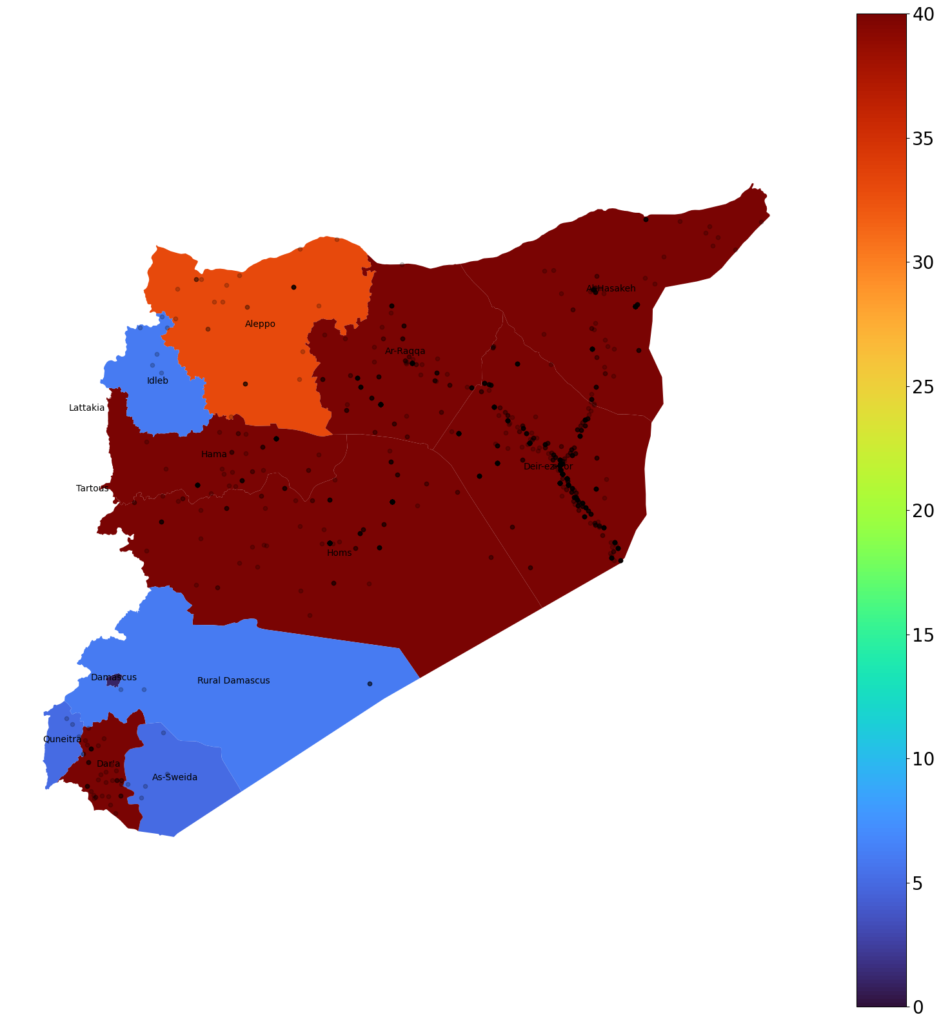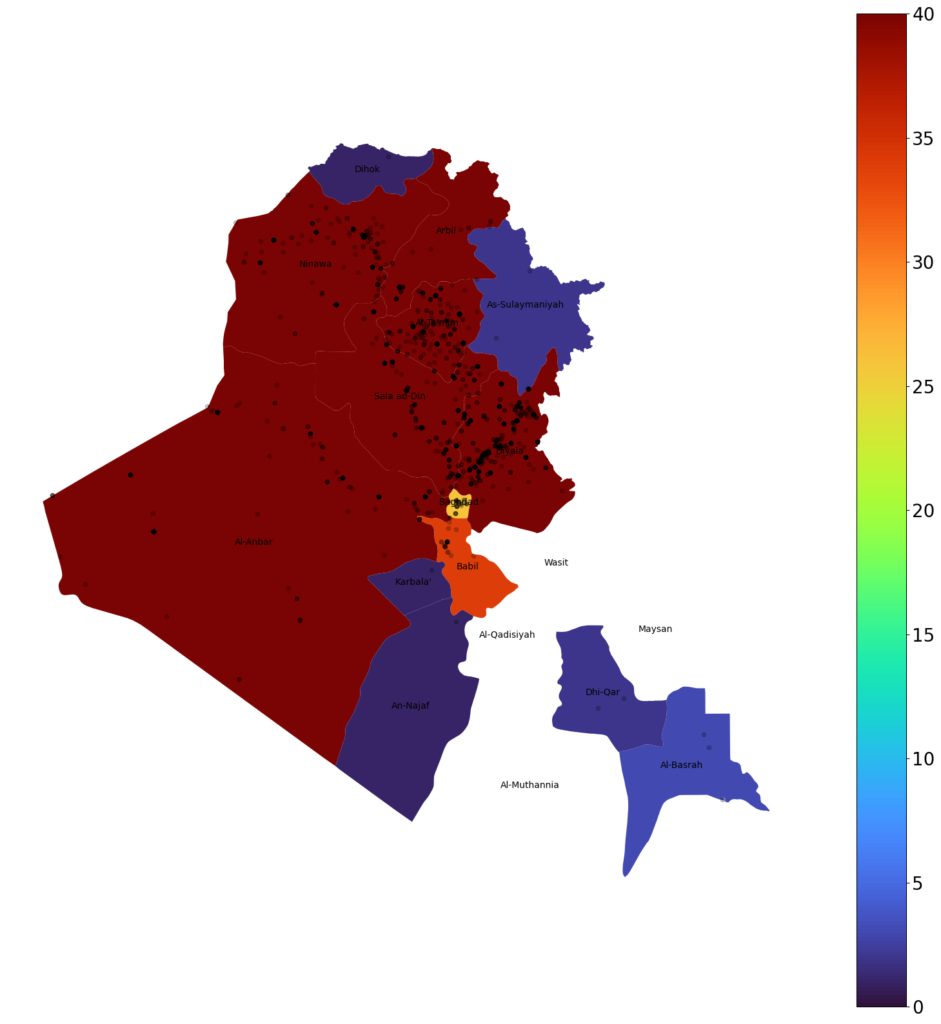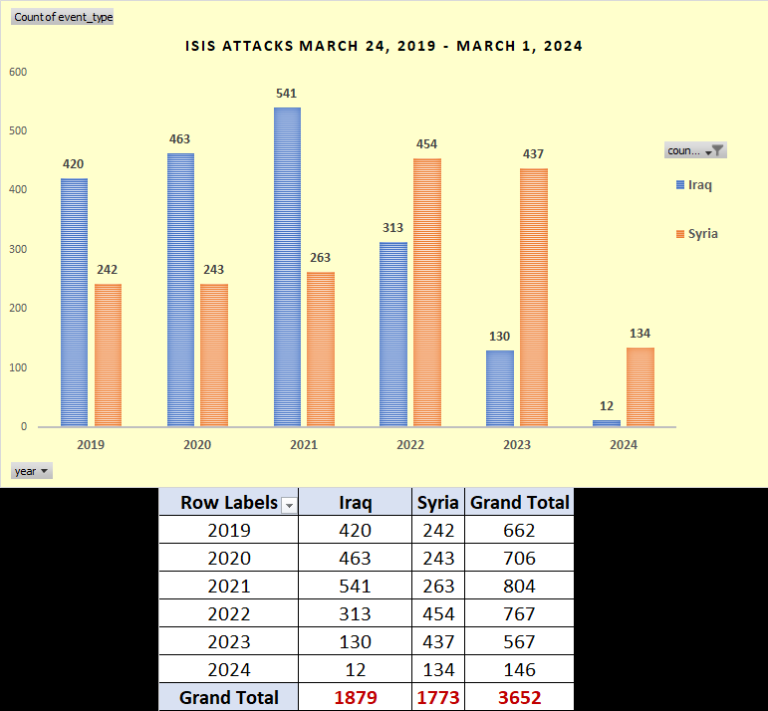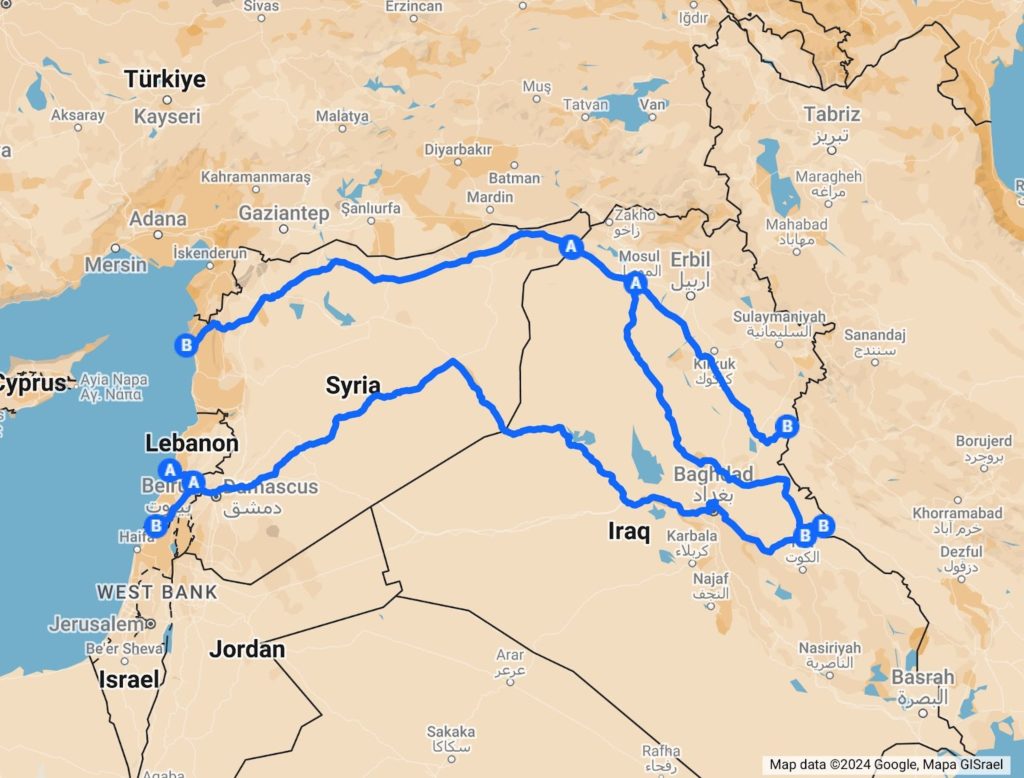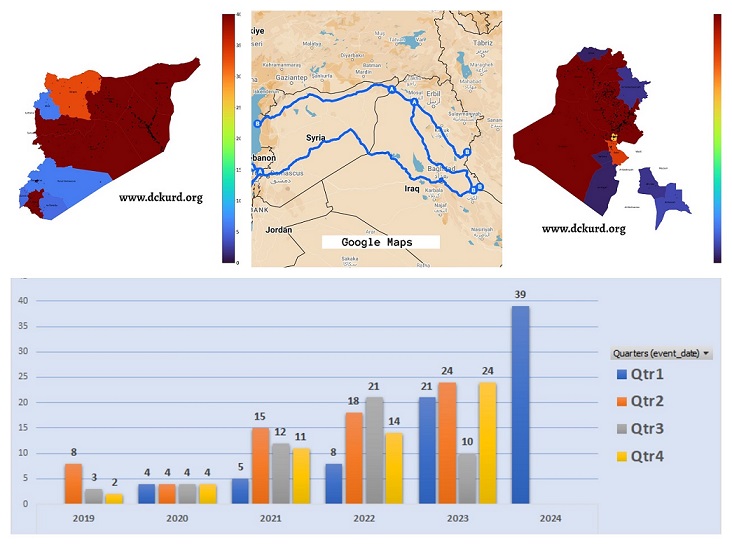
The potential withdrawal of the United States from Iraq and Syria poses a significant threat to US national security, exacerbating the already precarious situation in the region. Such a move would only serve to benefit America’s adversaries. Although the US has retaliated by targeting militants directly involved in killing American service members in Jordan and launching dozens of attacks on US bases, temporarily halting Iran’s plans, the Iranian regime persists in its goal to expel the US from Iraq and the broader region. Iran has shifted its focus to pressuring the Iraqi government for negotiations with the US, seeking a rapid withdrawal, despite opposition from Kurds, Sunnis, and certain Shiite parties.
Note: Conflict data are sourced from the Armed Conflict Location & Event Data Project (ACLED). ACLED data available at www.acleddata.com <http://www.acleddata.com>.
The few hundred US soldiers stationed in Iraq and Syria are integral to a larger international coalition that has been combating ISIS since 2014. While the US presence holds symbolic value, it plays a crucial role in leveraging Iraq and Syria to counter the terrorist group. This presence provides significant support to Iraqi and Kurdish security forces, offering training and equipment.
Despite improvements in the Iraqi military’s equipment and training, it still lacks the capability to confront ISIS independently due to issues like the group’s strong presence and lack of loyalty within the Iraqi army.
In Syria, the situation is complex, with the Kurdish-led Syrian Democratic Forces (SDF) proving effective against ISIS but lacking international recognition due to Turkish opposition and the Assad regime’s stance. The US presence in Syria serves national security interests, deterring Iran, preventing further Russian expansion, and combating terrorist groups like ISIS and al Qaeda, particularly in Turkish-occupied areas. Despite criticism, the Turkish government, led by President Recep Tayyip Erdogan, actively plays a revisionist role, contributing to conflicts in Syria and expanding influence across the Middle East and Africa. China’s growing intervention in Iran, Iraq, and Syria adds another layer of complexity to the region.
The following maps and charts depict the resurgence of ISIS following the physical defeat of the ‘caliphate’ on March 24, 2019, up to March 1, 2024
The emergence of ISIS in new territories like the Syrian Desert (Badiyat al Sham) of the Homs governorate, is notable. Since 2021, their expansion into the Syrian desert has formed a new nexus of instability, spanning Homs, Raqqa, and Deir Ez Zor governorates. This expansion potentially grants ISIS easier access to Idlib, where al Qaeda maintains strongholds. It’s worth noting that two ISIS leaders were killed in Idlib, including Abu Bakr al Baghdadi. Despite their ideological disparities, the prospect of future collaborations between al Qaeda offshoots like Hay’at Tahrir al-Sham (HTS) and ISIS looms if they face common pressures in their respective territories.
It is evident that both Iraq and Syria are poised for a resurgence of ISIS and other extremist groups should the U.S. withdraw. The aftermath of the partial U.S. withdrawal from Syria in 2019 led to increased instability, particularly with Turkey’s occupation of Sari Kani and Giri Spi, where radical groups supported by Turkey extended their influence strategically. Concurrently, the Assad regime, backed by Russia, gained control of additional areas, weakening the position of the Kurdish-led Autonomous Administration for North and East of Syria (AANES) against Damascus. Furthermore, a significant national security setback occurred when hundreds of ISIS terrorists escaped from a prison targeted by Turkey, leading to a loss for the U.S. and its allies in the region. Equally noteworthy, European powers followed the U.S. lead, highlighting that without American presence, no Western country can effectively maintain a foothold in the region.
The moment U.S. troops depart, the extensive investment made by the U.S. in Iraq since 2003 is at risk of disappearing. Despite a notable decline in the U.S.’ soft power over the past decade, the military presence has consistently reinforced diplomatic efforts. Notably, when the U.S. retaliated against Iranian proxies in Iraq, attacks on military bases and the embassy ceased.
The repercussions of losing Iraq would extend across the entire Middle East, potentially paving the way for rapid replacements by Iran, Russia, China, and Turkey. The aftermath may result in heightened political and military divisions within Iraq, leading to substantial losses for U.S. allies, particularly the Kurds. The Kurdistan region, paying the price for its alliance with the West and the U.S., has faced numerous attacks by the Islamic Revolutionary Guards (IRGC) and their Iraqi proxies since 2018.
Iran leverages the Iraqi supreme court to systematically dismantle the Kurdistan entity within a federal Iraq. Since 2022, the court has issued ten verdicts against Kurdistan, including significant rulings such as halting Kurdish oil production, annulling Kurdistan’s parliament, and altering election laws to diminish the authorities of the Kurdistan Regional Government (KRG) over the region.
U.S. and Western investments in Iraqi Kurdistan trace back to 1991 when the international community established a No Fly Zone (Operation Provide Comfort) to halt Saddam Hussein’s massacres against the Kurds. Despite minor setbacks, the Kurdish Region has been an unwavering ally to the U.S., even after the independence referendum led to attacks by Iran and its Iraqi militias, with the U.S. seemingly looking away.
In 2003, at the urging of the U.S., the Kurds opted to be part of a new federal Iraq, post Saddam Hussein’s regime, that ensured their rights. However, the Iraqi federal government has consistently undermined the region, including imposing a financial embargo in 2014 during the Kurdish fight against ISIS.
The US withdrawal signals the potential dismantling of the Kurdistan Regional Government (KRG) and the resurgence of an authoritarian Iraqi government influenced by Iran. Kurdish military forces will resist, leading to more wars and destabilization in the region. Areas of conflict will include the disputed territories, which have witnessed a significant ISIS presence since 2017. These territories hold strategic importance for Iran, providing a shortcut to Syria’s northeast, as depicted in the land bridge map below. Notably, on October 16, 2017, during the Kurdistan independence referendum, the deceased Iranian general Qassim Soleimani orchestrated attacks on the Kurds in the area, utilizing Iraqi proxies, including factions within the Patriotic Union of Kurdistan (PUK). Iran has exerted dominance over the region for over seven years, exploiting oil and drug smuggling routes, while leveraging political and geopolitical influence.
Simultaneously, Sunnis face pressure, with the supreme court removing the speaker of the parliament, paving the way for increased oppression by Iranian-backed militias. This could empower radical groups in the western part of the country, as it did from 2003 to 2014. The emergence and persistence of ISIS were not solely due to the organization’s strength; local grievances and the mismanagement by Baghdad played a crucial role. The marginalization of Sunnis provided fertile ground for ideological terrorists and leaders to exploit the issues between Baghdad and the Sunnis, recruiting many into the “caliphate.” Secular Shiites and those not aligned with pro-Iran factions will also likely become targets. Additionally, Iraq faces a democratic backslide with its already limited progress.
Post-U.S. withdrawal, Iraq is likely to experience civil unrest, the resurgence of terrorist organizations, and the dominance of anti-U.S. powers. The Iranian regime holds significant influence over Shiite parties, but it may exploit the instability rather than advocate for a strong Iraq. Despite using proxies to achieve its goals, Iran is unlikely to permit a robust Iraq, even under proxy governance, due to historical nationalist competition.
Like Iraq, Syria will face the same fate if not worse post the U.S. presence and the international community. It’s essential to acknowledge Syria has been at crossroads since 2011 as the uprising against the dictatorship failed to achieve its goals and opened a pandora box that contains radical regional and local actors.
First, Iran, the main supporter of the Syrian regime, is poised to enhance its influence over Syria, establishing a direct route from Tehran through Iraq to Syria and extending to Lebanon. While Iran’s current “land bridge” is operational, it faces hindrances due to the presence of the U.S. in Iraq and Syria. Moreover, Turkey’s conflict with the Kurds puts the Kurdish-led Autonomous Administration of North and East Syria (AANES) at risk of dissolution. In the event of their survival within a weakened entity, the Kurds may find themselves compelled to collaborate with Iran, thereby strengthening the Iranian regime. Essentially, Iran is likely to exert pressure on the Assad regime to employ the Kurds as a strategic tool against the Sunnis in the northern regions, transforming them into a symbolic entity.
Second, the paramount concern surrounding the U.S. withdrawal is the resurgence of ISIS. Regions like Deir Ez Zor are at risk of falling under terrorist control, with potential expansion into areas beyond their previous strongholds like Raqqa, extending west toward Homs. The persistent strength of ISIS, five years post the defeat of their ‘caliphate,’ can be attributed to the dire economic conditions faced by the population in liberated areas. Western countries have failed to implement effective stabilization programs for these communities. Moreover, the absence of international tribunals or recognition for the AANES courts to prosecute thousands of ISIS captives and their families contributes to the ongoing threat. Turkey’s prioritization of anti-Kurdish actions in Syria has further created an environment conducive to ISIS resurgence, enabling attacks on the Syrian Democratic Forces (SDF) whenever Turkey intervenes in the region. Therefore, the return of ISIS is a distinct possibility following the U.S. withdrawal.
Third, since 2011, Turkey has faced criticism for its role in Syria, supporting jihadists under the pretext of opposing the Assad regime. The country earned the moniker “Highway to Jihad” for serving as a conduit for ISIS to enter and exit Syria. President Erdogan’s Muslim Brotherhood ambitions led Turkey to compete for leadership in the Syrian uprising. With Russia’s approval, Turkey is expected to occupy more bordering towns and cities, seeking to dismantle the AANES and extend its influence along the borders.
Although Russia may oppose Turkey’s occupation of strategic towns like Manbij, it is likely to permit actions in areas such as Kobani, as seen in the 2018 Afrin occupation. Russia has facilitated talks with Turkey to revive the “Adana Accord,” allowing Turkey to occupy Syrian areas and “combat the PKK.” Turkey is expected to mobilize radical Syrian proxies, possibly including al-Qaeda affiliates, against the Kurds. Russia and Turkey are likely to collaborate after the U.S. withdrawal, with Russia seeking to counterbalance American support for Ukraine. Russia may take control of areas not occupied by Iran in the AANES, gradually restoring Assad’s regime power in Syria.
Ultimately, Russia/the Assad regime on one side and Turkey on the other might come to an agreement, designating the Kurdish region as a buffer zone—a sacrificial lamb for a short-term solution in the region.
Fourth, as China gradually expands its influence in the Middle East, recent developments, such as hosting Assad and winning massive energy contracts in Iraq, indicate its increasing role in the region. Consequently, these factors may weaken the U.S. alliance with Gulf countries, particularly as the U.S. shifts away from safeguarding its interests through a military presence—a shift criticized by emerging isolationist voices in both the Republican and Democratic parties.
The U.S. has a crucial role in Iraq and Syria, not only for national security but also for maintaining stability in the Middle East and preventing the eruption of conflicts similar to Gaza. The repercussions of reduced U.S. interest are not only felt by the America but also by European nations, considering their geographical proximity and Turkey’s provocative role in the refugee crisis. Both the U.S. and Europe must adopt a more realistic approach to unresolved issues, including addressing ISIS detainees, implementing comprehensive stabilization programs, continuing the anti-ISIS campaign, holding Iran accountable for proxy wars, and launching new efforts to ensure the protection of allies such as the KRG, the AANES, and pro-Western parties in the region.
One certainty is that multiple conflicts will erupt in the region, leading to the erosion of America’s position. The unfolding reality underscores the Middle East’s paramount importance for any major global power.

